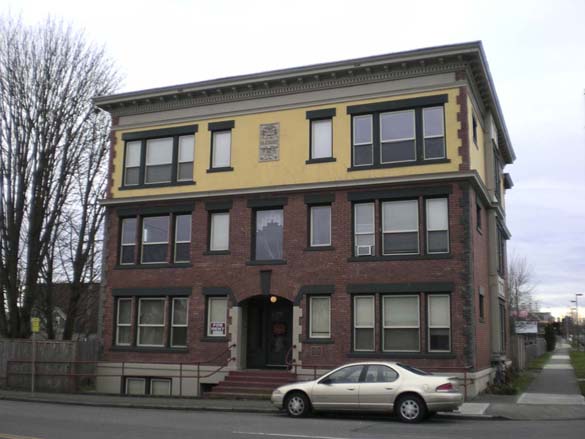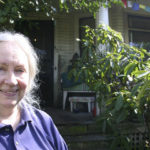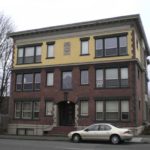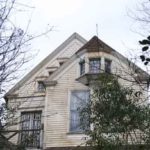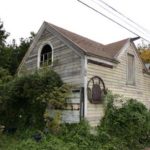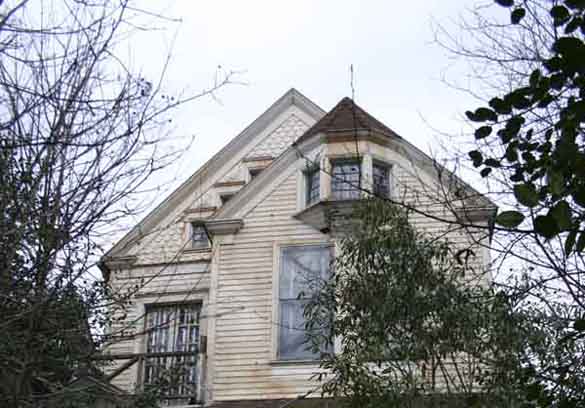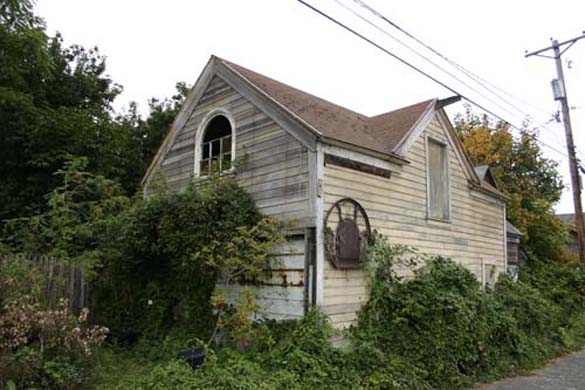Wedge neighborhood resident Diane Walkup likes to compare her 117-year-old home to a single-owner automobile — it has more than a few years on it, but it still runs great. The home was built before the automobile — a former carriage house in the backyard is one reminder. But for more than 90 years, the two-story, Victorian style home on the 400 block of South M Street was the residence of one family: the Alvin C. McIlvaines.
According to a 15-page Hilltop walking tour map and guide produced by the City of Tacoma’s Historic Preservation Office in 1997, McIlvaine, a contractor, arrived in Tacoma from Pennsylvania in 1893. He owned small parcels throughout Tacoma, and, in 1906, hired architect John P. Larkins to design an apartment building at 920 So. 9th St., near a streetcar line and the “K Street” Business District. In 1995, McIlvaine’s apartment building was added to the National Register of Historic Places.
The exact age of Walkup’s home has been a question for more than two decades (though it’s believed to be the oldest house on the block). A McIlvaine relative told her the house was built in 1886. According to the Pierce County Tax Assessor’s Web site, the house was built in 1900. Still other records say it was built in the 1890s.
But one source shows the house dates back to 1892.
“After checking our research here at the Tacoma Public Library, we are confident that the house was built in 1892,” says Brian Kamens, librarian in the Northwest Room of the Tacoma Public Library. According to Kamens, the house does not appear on the 1892 Sanborn Fire Insurance Map of Tacoma — a reliable source for historians. However, the Tacoma City Directory indicates McIlvaine lived in the house beginning in 1893. “We believe that the house was being built just after the completion of the 1892 Sanborn Map, in the last half of 1892,” says Kamens.
For Walkup’s part, she came to own McIlvaine’s former home through a circuitous route. She was born in Illinois and, after college, lived in Monterey, Calif., as well as one year each in Europe and New York City. She arrived in Tacoma with her then-husband, Bill Walkup, in 1977. After the Walkups divorced, Diane met Richard Turner, a preservationist. The couple bought the home in the fall of 1985. Today, Walkup lives alone at the residence.
“I’ve lived in this particular house longer than I’ve lived in any other place in my life — almost 24 years,” she says. “There were some times I thought of moving, but it’s really nice to live in the central part of town. I’m close to just about everything I need. I’m close to the things I like — the Grand Cinema, good restaurants, artist activities. Especially as I get older, I wouldn’t feel comfortable living out in the country. My needs are pretty much met in this part of town.”
For the past year, Walkup, who also owns an 1890s-era home next door, has been a regular sight at Tacoma’s Landmarks Preservation Commission (LPC) meetings. Last summer, a group of Wedge residents submitted an application to designate the Wedge neighborhood an historic district. According to the application, the Wedge is a part of Tacoma that boasts more than 50 homes dating back 80 years or more. It’s also where Tacoma pioneer Aaron Titlow, candy company entrepreneurs Frank and Ethel Mars, and Titanic survivor Anne Kincaid resided. And its ringed by Wright Park, the North Slope Historic District, and many of the city’s oldest churches.
Walkup has testified in support of the designation, and would like her neighborhood to receive the special protection afforded to historic districts.
The Tacoma Daily Index met Walkup in her home recently to discuss her involvement and interest in the Wedge neighborhood.
TACOMA DAILY INDEX: When and why did you first move to the Wedge neighborhood?
DIANE WALKUP: My ex-partner, Richard Turner, worked for the city’s department of historic preservation in the early-1980s or late-1970s, was a real preservationist. He would drive around just to look at houses. He spotted this house one day with a ‘for sale’ sign. It was so striking looking. His jaw dropped. He brought me by. We fell in love with it and bought it. That was in 1985.
INDEX: What did the neighborhood look like at the time?
WALKUP: This house had been vacant for a year. The owner died in 1984, and it was vacant for a year. The other houses, everything looked the same. At that point, all these houses were really cheap. This was over 20 years ago. It was close to the Hilltop. At that point, people still didn’t want to live in the inner-city. Although the Wedge, even then, had a really strong, cohesive, residential neighborhood group.
INDEX: What do you know about the home where you live?
WALKUP: I know a little. I wish I knew more. I thought it was built in 1886 because that’s what we were told by the nephew of the woman who lived here all her life — the house was built in 1886. But other records say 1890s. Alvin McIlvaine had two daughters: one married, one didn’t. The one who didn’t was Myrtle McIlvaine. She was a school teacher. She lived in this house her entire life. She died in 1984. So it’s like a car that’s just had one-family ownership. I’m guessing she was in her eighties. There are some historical apartments on South J and either 9th or 11th called the McIlvaine Apartments. I have done research in the Northwest Room, and Alvin had those apartments built and they were in the family for many decades. Those apartments, there’s a big plaque there — National Historic Register — which I think is a neat tie-in to this home. To think that those apartments are on the national historic register and the person responsible for them being built lived in this home.
INDEX: Can you describe the house? The style of architecture? How big it is?
WALKUP: I call it Victorian. I’m not an architectural historian. My home has a front hallway, little living room, dining room, and a kitchen. Upstairs there are three bedrooms and a bathroom. There’s a stairway leading from the bathroom up to the attic. It’s a really wonderful space. It’s almost like a third story. It even has some nice woodwork and detailing. It’s not just a crawl space — it’s a genuine large attic. At the rear of the house is a coach house, which is really neat. You don’t find many of those left. It was built before there were automobiles. It housed a horse, carriage, and there’s a hay loft.
INDEX: Was there any restoration work done to the carriage house?
WALKUP: That’s as is, except we jacked up one of the walls to level things out a little bit. It is in good shape. Also an interesting detail, the Tulip tree out front. We were told by the great-nephew of Alvin McIlvaine that the Tulip tree was planted by him at the completion of the house being built. So the tree is as old as the house. It’s healthy. It’s huge, but it’s healthy. I have it regularly looked after by a certified arborist.
INDEX: How long has there been an effort to create a historic district in the Wedge?
WALKUP: Well, an application was submitted last summer. But I think the actual work began in 2007. [Wedge resident and Landmarks Preservation Commissioner] Ross Buffington started to kind of re-activate the Wedge. What really triggered the re-activity in the Wedge was First United Methodist Church being torn down. That was a big warning because it was so close to us. That just triggered fears.
INDEX: What has been your interest and involvement in the historic district process?
WALKUP: Well, I actually did not participate in the application. Several people went ahead and did most of the research. One thing that stopped me is I’m not online yet. So I did not participate in this historic district nomination. I appreciate that the Wedge is seen as having historic value. I appreciate that Historic Tacoma is backing this effort.
INDEX: One recent development related to the historic district’s proposed boundary is a recommendation by City staff to exclude a row of old homes along the 500 block of South L Street. What is your opinion of that recommendation?
WALKUP: Those houses are not in the residential zoning, for starters. Visually, I like the historic houses. But I think that would be a real uphill battle. One individual who owns four or five houses is against the designation. I concur with that decision.
INDEX: What is the demographic of the neighborhood today?
WALKUP: Right now, on my block, it’s just younger people, working people. I’m probably one of the few people on this block right now who is semi-retired. A family just bought the house right across the street from me, which I’m absolutely thrilled about. They specifically bought in this neighborhood because they like the old houses, researched the history, they know the Wedge is involved in trying to preserve this block. They bought with the expectation these houses over here, on the east side of M Street, stay. I’m very happy to have them here. On the corner lives a woman and her child. There’s a family two houses down from me.
INDEX: There will be a survey in May to gauge residents’ support or opposition to the historic district plan. From my own experience reporting on the issue, I see the same small group of people from the Wedge at LPC meetings. Do you have any sense of whether the larger neighborhood supports or opposes the historic district proposal?
WALKUP: I think there will be support. I can’t predict exactly. I can’t say it will be unanimous. I just don’t know. It’s funny. I know you’re saying you see the same people at these meetings. It seems to be that’s the way it is in life. Certain people always show up. Other people may be interested, but they don’t have the time or the commitment to go to all the meetings. But I met a good number of people who attended some of the earlier meetings at Ross Buffington’s house [who supported the idea].
Todd Matthews is editor of the Tacoma Daily Index and recipient of an award for Outstanding Achievement in Media from the Washington State Department of Archaeology and Historic Preservation for his work covering historic preservation in Tacoma and Pierce County. He has earned four awards from the Society of Professional Journalists, including third-place honors for his feature article about the University of Washington’s Innocence Project; first-place honors for his feature article about Seattle’s bike messengers; third-place honors for his feature interview with Prison Legal News founder Paul Wright; and second-place honors for his feature article about whistle-blowers in Washington State. His work has also appeared in All About Jazz, City Arts Tacoma, Earshot Jazz, Homeland Security Today, Jazz Steps, Journal of the San Juans, Lynnwood-Mountlake Terrace Enterprise, Prison Legal News, Rain Taxi, Real Change, Seattle Business Monthly, Seattle magazine, Tablet, Washington CEO, Washington Law & Politics, and Washington Free Press. He is a graduate of the University of Washington and holds a bachelor’s degree in communications. His journalism is collected online at wahmee.com.
